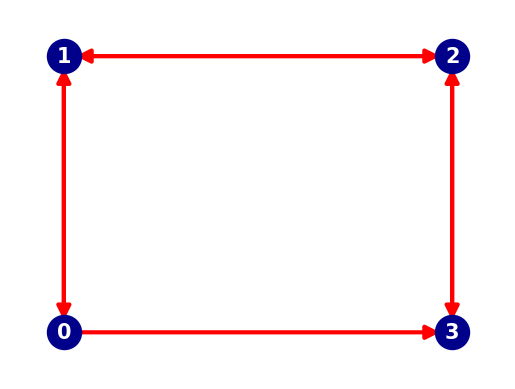Defining a basic transport network#
In this notebook, we show how to setup a simple transport network.
We take the following steps:
1. Imports#
We start with importing required libraries
# package(s) used for creating and geo-locating the graph
import networkx as nx
import shapely.geometry
# package(s) related to the simulation (creating the vessel, running the simulation)
import opentnsim
# package(s) needed for plotting
import matplotlib.pyplot as plt
print('This notebook is executed with OpenTNSim version {}'.format(opentnsim.__version__))
This notebook is executed with OpenTNSim version 1.3.7
2. Create graph#
OpenTNSim works with mix-in classes to allow for flexibility in defining nodes.
A graph contains nodes (blue dots in plot below) and edges (red arrows in plot below).
# specify a number of coordinates along your route (coords are specified in world coordinates: lon, lat)
coords = [
[0,0],
[0,0.1],
[0.1,0.1],
[0.1,0]]
# make your preferred Site class out of available mix-ins.
Node = type('Site', (opentnsim.core.Identifiable, opentnsim.core.Locatable), {})
# create a list of nodes
nodes = []
for index, coord in enumerate(coords):
data_node = {"name": str(index), "geometry": shapely.geometry.Point(coord[0], coord[1])}
nodes.append(Node(**data_node))
# create a graph
FG = nx.DiGraph()
# add nodes
for node in nodes:
FG.add_node(node.name, geometry = node.geometry)
# add edges
path = [
[nodes[0], nodes[3]], # From node 0 to node 3 - so from node 0 to node 3 is one-way traffic
[nodes[0], nodes[1]], # From node 0 to node 1 - all other edges are two-way traffic
[nodes[1], nodes[0]], # From node 1 to node 0
[nodes[1], nodes[2]], # From node 1 to node 2
[nodes[2], nodes[1]], # From node 2 to node 1
[nodes[2], nodes[3]], # From node 2 to node 3
[nodes[3], nodes[2]], # From node 3 to node 2
]
for edge in path:
FG.add_edge(edge[0].name, edge[1].name, weight = 1)
# create a positions dict for the purpose of plotting
positions = {}
for node in FG.nodes:
positions[node] = (FG.nodes[node]['geometry'].x, FG.nodes[node]['geometry'].y)
# collect node labels
labels = {}
for node in FG.nodes:
labels[node] = node
# draw edges, nodes and labels.
nx.draw_networkx_edges(FG, pos=positions, width=3, edge_color="red", alpha=1, arrowsize=20)
nx.draw_networkx_nodes(FG, pos=positions, node_color="darkblue", node_size=600)
nx.draw_networkx_labels(FG, pos=positions, labels=labels, font_size=15, font_weight='bold', font_color="white")
plt.axis("off")
plt.show()

3. Inspect paths#
It is interesting to see that to go from Node 0 to Node 3 there are now two available paths.
print([p for p in nx.all_simple_paths(FG, source=nodes[0].name, target=nodes[3].name)])
[['0', '3'], ['0', '1', '2', '3']]
